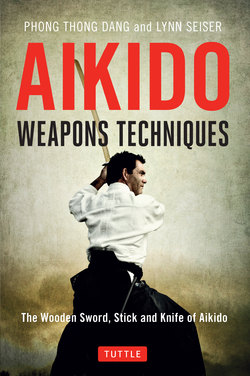Читать книгу Aikido Weapons Techniques - Phong Thong Dang - Страница 8
ОглавлениеIntroduction
The history of the world is often told by the history of war, recorded by the victor. Warriors have always used weapons to fight wars, and any complete fighting system includes the use of weapons. While aikido is an effective and efficient means of self-defense and protection—popularly practiced primarily as a means of personal, social, and spiritual development—it is still, at its core, a martial art.
JAPANESE WEAPON ARTS
The mystique of the use of Japanese weapons appears in the Kojiki or legendary stories of old Japan. The Japanese feudal warrior was called bushi, but later commonly became known as samurai (meaning “to serve”), in the Muromachi period (1392–1573). The bushi’s trade was bugei, or martial arts. Bugei, combative effective martial art systems, were known by the jutsu suffix. They developed systematically from around the tenth century, through vigorous traditional training discipline, for the sole purpose of group protection. The martial arts included both unarmed and armed fighting arts, as well as arts of camouflage and deception, binding, speed walking and running, jumping, climbing, dodging, swimming, fortification, deployment, gunnery, and fire. Within those armed or weapons martial arts were kyu-jutsu (bow and arrow), so-jutsu (spear), gekikan-jutsu (ball and chain), shuriken-jutsu (blade throwing), jutte-jutsu (metal truncheon), tessen-jutsu (iron fan), tetsubo-jutsu (iron bar), sodegarami-jutsu (barbed pole), sasu-mata-jutsu (forked staff), and juken-jutsu (bayonet). The more common weapons were ken-jutsu (offensive swordsmanship), iai-jutsu (defensive swordsmanship), bo-jutsu (staff over five feet long), and jo-jutsu (staff or stick under five feet long). (Draeger and Smith 1969, p. 83)
The bushi’s moral code of ethics, moral standards, philosophy, and national consciousness was bushido, “the way of the warrior.” Many recognize three ages of bushido: ancient martial bushido of the eleventh century, reformed bushido of the seventeenth century, and modern bushido of the nineteenth century (Random 1977, pp. 36–37). The essence of bushido lay in justice, courage, benevolence, politeness, honesty, honor, and loyalty (Draeger and Smith 1969, pp. 88–89). The role of the samurai is tied to the core concept of giri, or duty. To be of service to his lord, the samurai followed the duty and obligation of his status and training by being the best warrior, soldier, bodyguard, and protector possible. The eleven volumes of Hagakure, completed in 1716, are a classic in bushido. The presence and acceptance of death was a central theme. Although idealized and romanticized, the life of the samurai was one of self-sacrifice, loneliness, danger, and inevitably death (with honor, it was hoped).
O’Sensei Morihei Ueshiba embodied the true spirit of budo with the traditional values, ethics, and social responsibilities of a warrior.
The way of life of a bushi was to be a warrior and fight wars. Later, the way of life of a samurai was to be of service in other ways as well. Both periods and ways of life followed the guidelines of bushido and became known as budo. The do arts evolved from the jutsu systems, beginning in the eighteenth century. They were concerned with the “higher aims,” spiritual discipline and both mental and physical self-perfection (Draeger and Smith 1969, pp. 90–91). Jutsu arts are effective and efficient practical application systems of fighting and combat. Do arts are oriented toward personal and spiritual development through physical training. Aiki-jujitsu evolved into aikido. Ken-jutsu and iai-jutsu evolved into iai-do, kendo, and aiki-ken. Jo-jutsu evolved into aiki-jo. Aikido is a modern art in the true traditional budo sense.
It can be said that aikido buki-waza, or weapons techniques, comes from “empty-hand” techniques, and that empty-hand techniques come from weapons. The two, though often thought of as very different, are very much an interrelated and interdependent extension of each other. No empty-hand system is complete without weapons training, and no weapons system is complete without knowing how to fight with empty hands.
